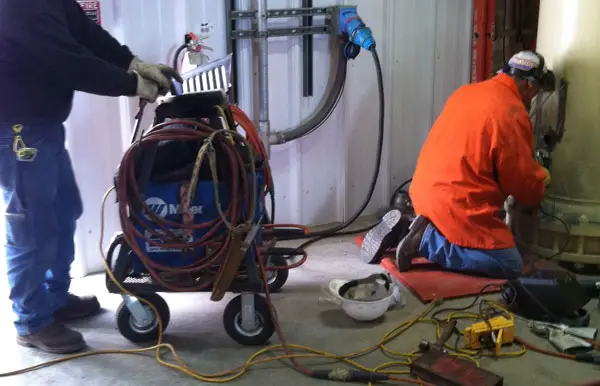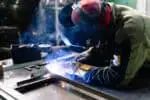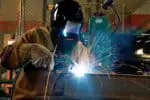Getting your welder started can be tricky if you are not aware of certain essential factors. Knowing the amperage and voltage capacity of your welding machine is one of the basic things that you need to look into before you start welding.
As a layman, the question of whether you can plug your welder into your regular outlet would be the first thing that comes to your mind. And that is why I am going to address the same in the blog and explain a little bit more about welding at home.
Plugging an arc welder into a regular outlet is possible if the welder you have runs at 120V. Outlets at home are capable of handling electricity to a limit. Hence, if your welder needs more than 120V you will have to use an additional setup like an adapter to regulate current flow.
Why does the question of outlet capacity arise in welding?
A house circuit is built to handle only a limit of a certain number of units of current. Anything more than that can affect the wiring system causing it to blow due to the extra load.
In most of the welders, some breakers shut down the system once the amperage and voltage flow get beyond the limit that the machine can hold.
When you connect a welder to an outlet, make sure to know the outlet handling capacity so that you can be aware that the welder is compatible with the outlet.
In case the house outlets are not enough new ones are to be built to make the machines work. You can find several videos on the internet that explains how to install an outlet suitable for your welder needs.
What is the minimal outlet handling capacity?
If you are looking for a welder that can be used without any difficulty and additional setup to run, you can go for Millermatic 141 MIG welder.
This welder does not require more than 120 V amperage. As such, you can go for the machine without a second doubt for your household welding needs.
Given below are the features of the Millermatic 141 welder that makes it an ideal choice for household works apart from its 120V capacity:
1.) Fixed and flexible!
The auto set is an attractive and very useful feature for a welder. Once you set the parameters you can use the same for every other work that you do unless you need to change the settings for specific welding purposes. Thus it also gives you the freedom to set them manually.
2.) Protection from voltage overload!
If the amperage is too much or the duty cycle is exceeded, the machines get shut down thanks to the Thermal overload and ‘Tip Saver’ short circuit protection. This extends the life of the machine by protecting it from damage.
3.) Generators are friends!
Millermatic 141 MIG welders are compatible with generators and when used with big ones, these machines tend to work to their full capacity. They are therefore very compatible with generators making them user-friendly.
4.) A smooth start to get the ball rolling!
The welder offers a spatter-free starting making it extremely easy to handle.
A machine that chokes continuously will not give a smooth initiation to the process and can affect the quality of the weld. Here you are saved from all these troubles.
5.) No switch needed!
Spool guns are easily detected when connected so a switch to accommodate them is not a part of the machine.
6.) Grooves of all kinds.
There are three grooves rendering the setup of wire an easy process. Two grooves are for solid wires while one is for flux-core wire.
7.) Smooth feeding facility.
The wire drive and consistent feeding setup of the same ensure that the process happens without any obstructions.
See also: Are 120 Volt Stick Welders Any Good?
When do you need high voltage welders at home?
High voltage welders are the ones that you cannot plug into your regular outlet. For these, you will have to set up an outlet that can handle the high flow of current.
For instance, a 220V welder cannot be plugged into a regular outlet. You will have to arrange everything that can help run a welder that needs the energy of that level.
Even though there are instructions such as these available on the internet explaining how to do this, you should get the help of a professional such as an electrician to install an outlet.
What to look for while plugging the welder at home?
You need to look into certain factors before you plug in your welder to ensure the safety and smoothness of the process:
1.) No wetness!
Make sure that there is no wetness anywhere near the machines or the outlet. The presence of liquid can increase the riskiness of the whole process.
Electric shock is a common problem during welding irrespective of the stage of work you are in.
2.) Taut connections!
Keep an eye for the tightness of the wires. They should be stretched enough to not affect the flow of the current. Loose connections can lead to disruptions resulting in the breakage of the work.
3.) Take time and know everything!
Study the equipment involved. This is necessary so that you can have an idea as to the needs of the machines.
A thorough knowledge about the capacity of the machine and its working is essential to have a doubtless welding experience.
This will help to bring in additional support if needed to regulate the current flow. So take time to analyze the whole setup before you start.
Conclusion
No matter how expert you are, make sure to ensure safety before you start your welding works.
Plugging a regular arc welder with less than 120 V might give you trouble but do keep an eye if you are going for higher voltage machines.
Take all the precautions and make all the setup before you start your work.








